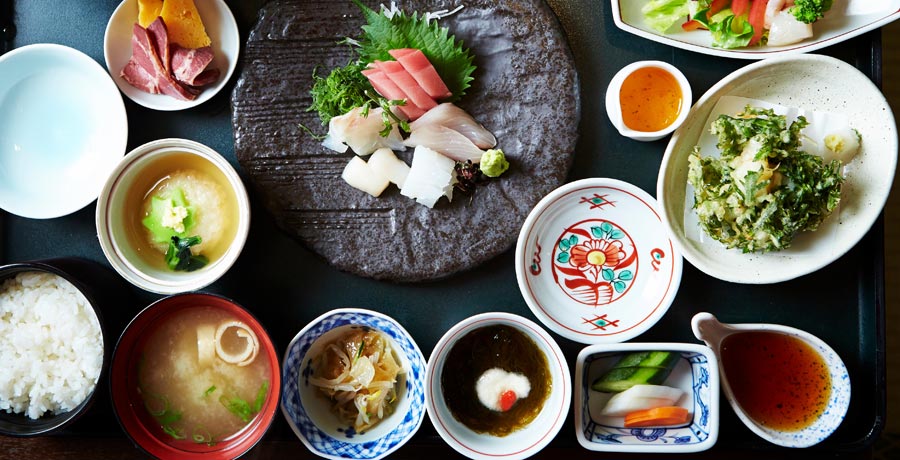If you are new to Japanese food then some of the ingredients or even the terms that are used to describe it can seem very strange and may even put you off trying them.
I think it’s true to say that most Japanese food that we eat in the UK has been westernised in some way; in the meat, fish and vegetables that are used and often too the way it is presented or put together.
When you visit Japan, this can come as a surprise as it turns out that what you thought you liked is quite different in the country where it originated!
In this blog, I’ve tried to be honest about what the more cautious eater might be worried about when wondering what to eat in Japan. I’ll talk about some of the Japanese foods that are unusual to find in the UK but are really delicious and that we shouldn’t be scared to try.
Ume boshi and other pickled vegetables

Pickled things in the UK are vegetables that have been preserved in vinegar, maybe with some spices and other seasoning, kept in glass jars for months, sometimes years, before being deemed ready to eat. They have a strong flavour and tend to be served with meat, fish and cheese.
Japanese pickles, or tsukemono, tend to be preserved mainly in salt, with rice vinegar, sugar, miso or other fermented seasoning to add flavour.
Some, like ume boshi, are preserved for a long time before being eaten but others might just be pickled overnight or for a few hours, just long enough for the vegetables to become crunchy, delicately sweet and sharp before being served as an accompaniment to your main meal.
Many different sorts of vegetables might be pickled in this way including daikon radish, aubergine, ginger and cucumber.
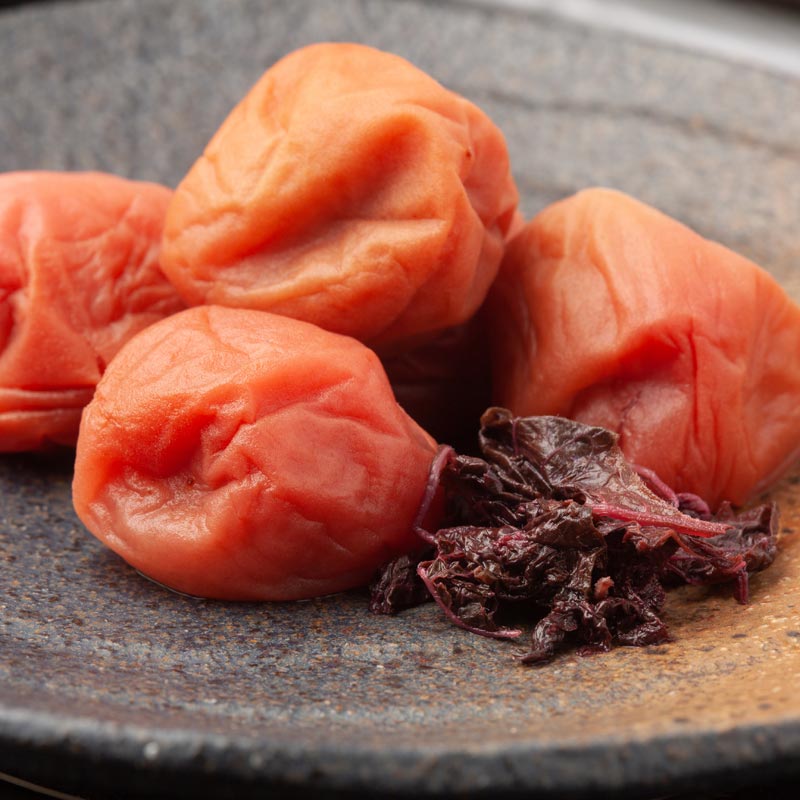
Ume boshi is a small plum that has been preserved in salt for a year or more and flavoured with red shiso leaf which also gives them a gorgeous red colour.
To hear Japanese people talk about ume boshi, you would think that it was so sour that you'd wonder why anyone would serve it with their food!
In reality, ume boshi does have a salty, sour taste but it’s not much stronger than any other pickled veggie and it goes really well with beautiful Japanese rice. You may see it as a whole, pitless shrivelled topping to your bento rice or it could be finely chopped into a rough paste and used as a filling for an onigiri rice ball. It is also used to season or accompany fish and meat dishes.
In general, Japanese pickles have a lighter flavour than you might expect and are a really good side dish for curry, sushi, sashimi, tempura and donburi as their sharpness contrasts beautifully with rich umami flavours and oily fish. They are almost always included in a tiny dish with your teishoku or alongside your kaiseki meal.
Rice balls
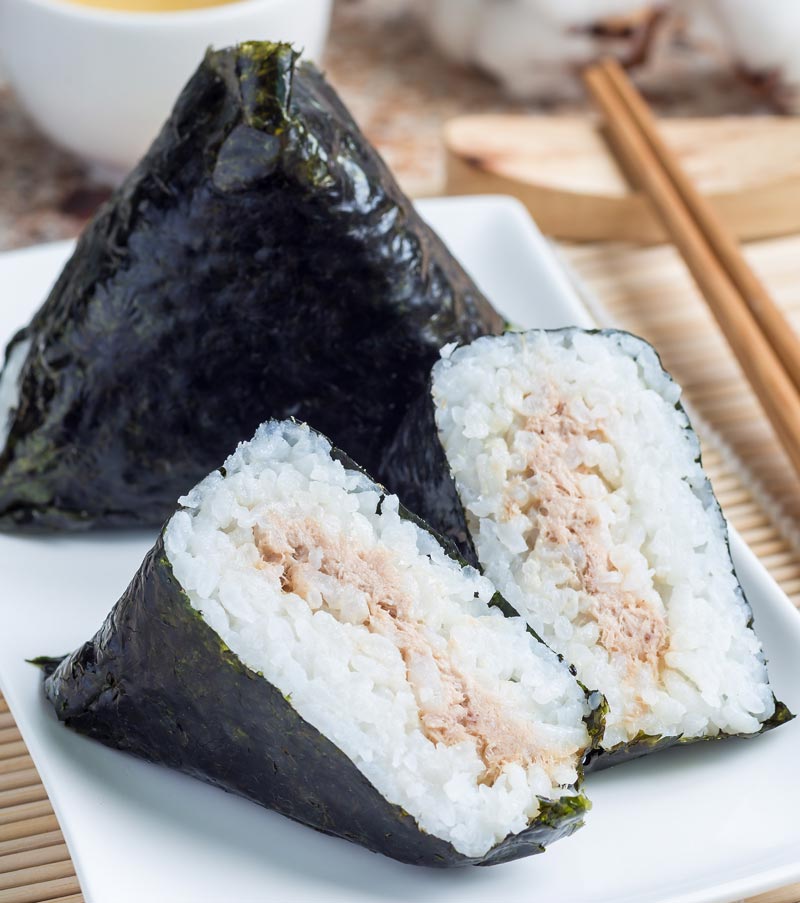
A rice ball? That’s going to be rather plain, isn’t it? Well, think again and let me reassure you that the simple onigiri, or rice ball, is delicious.
First off, Japanese rice is not the same as the long grain rice we eat here. It’s fluffy, soft and sweet and really has a delicious flavour.
Sometimes you might get a very simple rice ball flavoured with a little sea salt but often it’s wrapped in crispy nori seaweed and will contain at its centre a tasty filling which could be anything from ume boshi to tuna mayo.
A single rice ball is quite filling and makes a really good snack or part of your bento lunch. You can buy them easily at convenience stores and food kiosks such as Family Mart and Lawson.
Raw stuff
Well, here’s the big one of course. Japanese cuisine is famous for raw fish and shellfish served as sashimi and sushi toppings.
Before I had ever tried any Japanese food, the idea of eating raw fish sounded awful and I never thought I could become a fan. Now, of course, I love it!
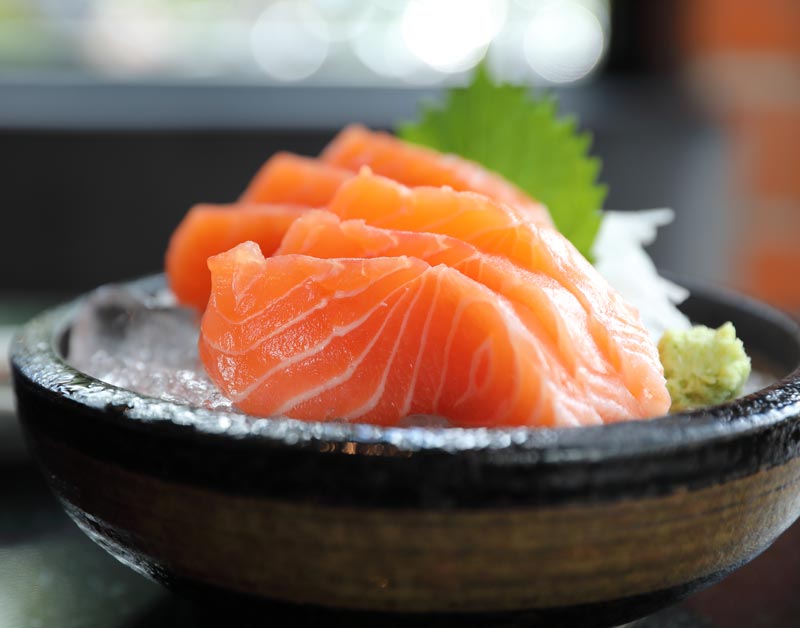
I think most westerners think that raw fish is going to taste really, well, fishy but in an unpleasant way and maybe think that the texture will be similar to raw meat. However, the experience of eating raw fish is completely different and probably very different to what you are expecting.
If you’re a newbie, I would suggest starting with tuna and salmon. Both tuna and salmon sashimi, whether on its own or as a topping on nigiri sushi, are soft, easy to chew and have a very delicate flavour. If you’ve eaten smoked salmon, then you’ll find the texture similar but the flavour is far less strong and the fish flesh is softer, almost melting in the mouth.
Mackerel is another type of fish that you might recognise and, served raw including the skin, is really delicious with a slightly stronger flavour. It all goes perfectly with sushi rice and accompanied by wasabi and pickled ginger.
Some types of raw fish are quite chewy and have a harder texture. They still taste good but do take some jaw work before you can swallow them. Ones to look out for are octopus, squid and cuttlefish.
Eggy things

In Japanese cuisine, egg is used a lot. It can appear in or on your soup, as an omelette or raw on top of your rice. You won’t believe how good egg tastes with dashi, soy sauce and Japanese rice. Even a Japanese boiled egg is not really the same as those we have here.
Raw egg is used as a dip in sukiyaki. After the meat is cooked, dip it in the accompanying raw egg before you eat it. It’s really good!
Don’t be scared when you see a raw egg in Japan. In Japan, eggs are very fresh and there is no problem with eating them raw. Although, if you’re pregnant or have some other health problem then you might understandably make the decision to avoid them.
We tend to think of cooked egg as somewhat heavy with a strong taste and eggy smell. But when cooked in Japanese style with dashi, soy sauce and mirin, the egg has a much lighter taste, with a little sweetness and umami from the seasoning.
Egg drop soup is where whisked egg is drizzled into a dashi (fish stock) based soup to form ribbons. Again, egg in a soup sounds horrible but it isn't! The flavours work together to make a warming, comforting dish.

Chawanmushi is a savoury dish of steamed egg that has been set like custard and might include some small vegetables such as mushroom, shellfish like crab or prawn and some other ingredients.
It’s served in a small Japanese cup with a lid which always feels a bit ominous when presented for the very first time.
We’re not really used to seeing this kind of food and most set foods in the UK are sweet and cold like jelly or blancmange. So when you first take a mouthful, the smooth jellified texture plus the fact that it’s warm might take you by surprise. However, once you get over the fact that it’s not sweet and think of it more as a set soup, you will find chawanmushi very pleasant and comforting to eat.
Seaweed
We are used to seeing sheets of nori wrapped around sushi rolls or rice balls but ‘garnished with seaweed’ sounds like your dinner will be adorned with fronds of damp kelp. Our vision of seaweed is a slimy, vegetable matter that smells strongly of the seaside.

However, the seaweed used in Japanese cooking has delicate flavours, often providing the typical ‘umami’ taste of many Japanese dishes. It is often dried or toasted like nori and aonori and has a nutty, salty, sweet flavour that’s a great condiment for rice, egg and pancake style okonomiyaki.
Other types such as kombu and wakame are used to flavour soup and ramen. These also often start out as dried ingredients that are rehydrated before being used in a recipe.
Something else you may come across is 'seaweed paste' or 'tsukudani'. Now, a paste made out of seaweed really does sound unappetizing and in all honesty this one doesn't look that nice either. However, it might be easier to think of it as seaweed jam or relish since the taste is really good, especially with fluffy white rice, and it has that sweet/savoury flavour that is so typical of Japanese food.
Offal
Depending on your age, the thought of eating heart, tongue, liver and kidney will have you salivating with hunger or recoiling in horror.
In the west, offal isn’t something many of us would choose to eat, often inviting scrunched up noses and flat refusal. It has become fashionable again in some quarters, along with cheaper cuts of meat such as oxtail, mutton and beef skirt, in some part because of the rising cost of living but also being served in trendy high end restaurants or recommended by TV chefs. However, it's not on the top of most people's list even though, when cooked properly, offal can be nutritious and tasty.
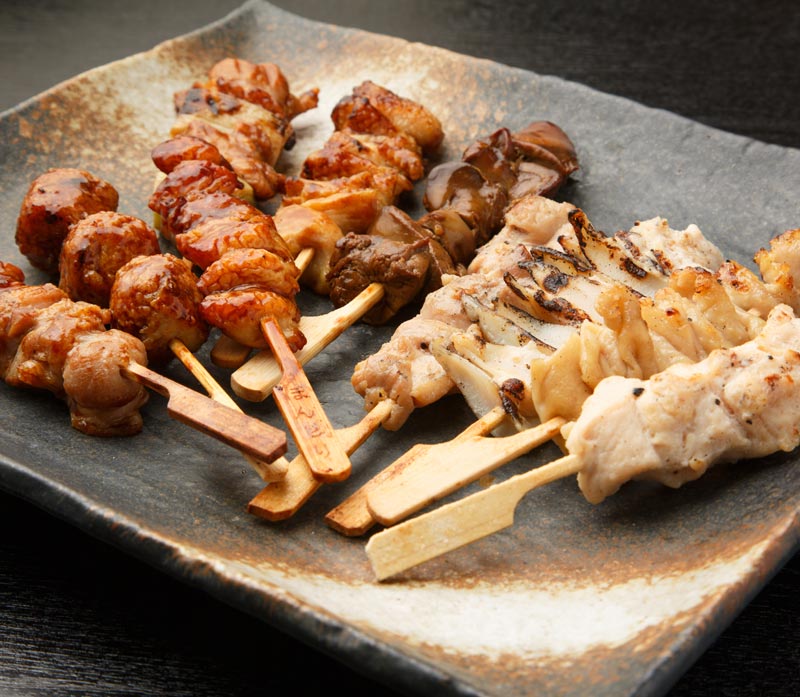
In Japan, culturally it’s desirable that very little of the animal that gave its life is wasted and it’s common to find liver, kidney and tongue on the menu. I have been served all these things in restaurants and izakayas plus intestines, tripe and cartilage.
Many people know about yakitori, chicken on skewers, but when you order it in the izakaya you will usually get a platter of skewers which will include chicken thigh meat, chicken with Japanese leek but also skewers of fatty chicken skin, chicken liver, chicken hearts and probably crunchy cartilage too.
If you’re not expecting it, it can be quite surprising and possibly a little disappointing if you thought ordering grilled chicken was a safe bet. However, please at least try some of these since they are all cooked in delicious yakitori sauce and are better than you might think.

Motsunabe is a hot pot dish (nabe) where chicken, pork and beef offal are cooked at the table with vegetables in a delicious soup.
Yakiniku restaurants in Japan, where a charcoal grill is set into the centre of the table and you order raw ingredients to cook yourself, are popular with westerners. You cook it to your liking, right, so what could go wrong?
Along with the wagyu steak and vegetables however, you might be offered (or find that you ordered by mistake) tongue, cows intestines, stomach, liver and heart. Japanese people love these and when marinated and grilled over charcoal are really delicious with lots of flavour.
Eel
If all you know about eel is the disgusting abomination we Brits call 'jellied eels' then you'd be forgiven for avoiding this particular fish at all cost.

However, eel in Japan is nothing like this. Eel is a fatty, tasty fish and the best type is grilled, coated with a rich sticky-sweet sauce and served on rice known as 'unadon' (unagi donburi). It can also be served as a sushi topping.
The texture is similar to any other grilled fish, soft and flavourful. If it has been prepared well you won’t find any bones and it really tastes wonderful on rice.
Unadon is one of my favourite Japanese foods.
And if you really don’t like it…
It can be embarrassing and sometimes panic inducing when a dish is put in front of you and you really don’t like the look of it. But no one is going to force you to eat anything. You’re an adult after all, so behave like one and either politely decline or leave it on your plate.
Each of us is an individual with our own tastes and from time to time I have heard even a Japanese person say that actually they don’t like something that is considered a delicacy.
In almost every case, I would encourage you to at least give each dish a try before deciding whether or not you eat it (although, feel free to read my blog about the infamous fugu!)
Japanese food is really good, often healthy and made with fine quality ingredients and, once your palate has become accustomed to the new flavours and textures, it’s kind of addictive too!
